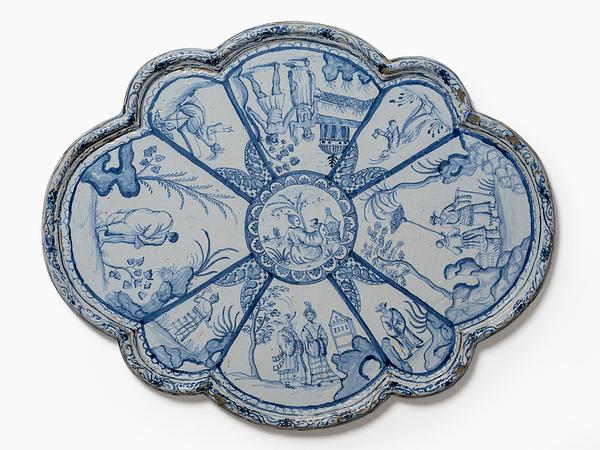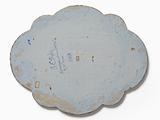Plateau; faience
Store Kongensgade Faience Manufactory, 1726
L: 55 cm
The first faience manufactory in Scandinavia was founded in Copenhagen in 1722. Housed on a large plot of land in Store Kongensgade, the enterprise was awarded exclusive rights to manufacturing faience with decorations done in blue. The first director was Johan Wolff, who had some time previously obtained the Danish king’s permission to experiment with the production of faience at Frederiksberg, a district of Copenhagen. However, Wolff quickly fell out of favour, and in 1727 a new manager was appointed, the German Johan Ernst Pfau (1706–1786).
The oval plateau in The David Collection is believed to be one of Pfau’s first pieces created at the Store Kongensgade Faience Manufactory, an assessment based primarily on the signature and dating:
J.E. Paue, Copenhagen, anno 1726 d 30 decem / SJSR. Furthermore, the shape and decoration of the plateau is atypical for the manufactory, giving rise to theories that it may be a trial piece with which Pfau could document his skill before acceding to his new office in Copenhagen.
[1]The plateau, which has a scalloped, profiled edge, is divided into eight fields: four larger and four smaller. All fields are decorated with exotic scenes in blue.
[2] In the centre of the plateau is a circular field depicting a scene presumably chosen to reflect the intended use of the piece: a figure with their back turned towards us sits on the ground in a landscape with a few trees and bushes. In front of the figure who holds a cup with accompanying saucer is a kind of container that could conceivably contain hot water.
Inv. no. NF 46
Published in:
Danske Fajancer fra det 18. Aarhundrede, Det danske kunstindustrimuseum, København 1931, cat. 105, p. 26 and ill. p. 29;
Albert Øigaard: Fajancefabriken i Store Kongensgade, København 1936, p. 40 and cat. V;
Dansk Kunsthåndværk gennem 400 Aar. Kunstindustrimuseets Jubilæumsudstilling Maj-Juni 1946, København 1946, cat. 173;
C.L. David: ”Fajancefabriken i Store Kongensgade” in C.L. Davids Samling, Tredje del, København 1958, pp. 6-7 and 21;
C.L. David: C.L. Davids Samling, København 1960, p. 47 (mentioned);
Kai Uldall: Gammel dansk fajence: Fra fabriker i kongeriget og hertugdømmerne, København 1961, pp. 14-15, 20, 31 and ill. 4;
Jørgen Ahlefeldt-Laurvig and Kai Uldall: Fajencer fra fabriken i St. Kongensgade, København 1970, pp. 37-38 and fig. 11;
Dansk kunst og kunsthåndværk, Davids Samling, København 1972, p. 37 and pl. 20;
Tove Clemmensen and Mogens B. Mackeprang: Kina og Danmark 1600-1950: Kinafart og Kinamode, København 1980, p. 102 and fig. 59, p. 101;
Verner Jul Andersen: Dansk kunst og kunsthåndværk, Davids Samling, København 1983, cat. 107, pp. 44-45;
Ole Villumsen Krog (ed.): Skatte fra kejserens Kina: Den Forbudte By og det danske kongehus¸ Christiansborg Slot, København 2006, cat. 222, pp. 643-644;


